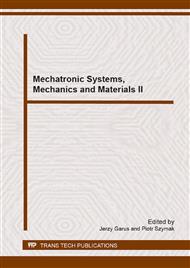p.9
p.14
p.20
p.26
p.32
p.40
p.50
p.58
p.65
Create Terrain Maps for Unmanned Ground Platform
Abstract:
A typical unmanned and remotely operated platform is usually equipped with cameras which give insufficient information about the nearest environment and an operator has difficulties in driving such a platform in unknown environment. In this paper, a problem of the platform nearest area map building based on additional devices is considered. The platform is equipped with SICK LMS lasers, inclinometer and radars. Combining information from the devices allows to build a map which helps an operator to drive the platform more efficiently.
Info:
Periodical:
Pages:
32-39
Citation:
Online since:
October 2013
Authors:
Price:
Сopyright:
© 2014 Trans Tech Publications Ltd. All Rights Reserved
Share:
Citation:


